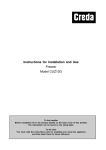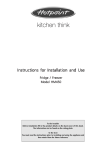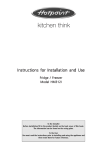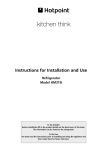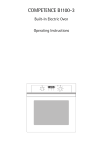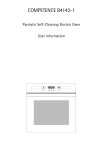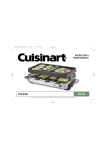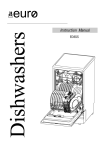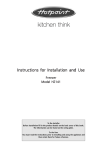Download Instructions for Installation and Use Fridge Freezer Model CM31GI
Transcript
Instructions for Installation and Use Fridge Freezer Model CM31GI To the Installer Before installation fill in the product details on the back cover of this booklet. The information can be found on the rating plate. To the User You must read the instructions prior to installing and using the appliance and then retain them for future reference. CONTENTS Product Safety Installation Electrical Connection Get to Know your Appliance Getting your Appliance ready for use How to use the Refrigerator Compartment Storage Guide How to use the Freezer Compartment Food Storage Energy Saving Tips Caring for your Appliance Troubleshooting Notes Key Contacts 3 3 4 5 6 6-7 7 8 9-10 11 12 13 14-15 Back Cover Retention of this Instruction Book This Instruction Book must be kept handy for reference as it contains important details on the safe and proper use of the appliance. If you sell or pass the appliance to someone else, or move house and leave it behind, make sure this Book is also provided so the new owner can become familiar with the appliance and safety warnings. If the Book is lost or damaged a copy may be obtained from: GDA LTD., Morley Way, Peterborough, PE2 9JB GB 2 PRODUCT SAFETY ATTENTION Read your manual carefully since it contains instructions which will ensure safe installation, use and maintenance of your appliance. Your Refrigerator is built to International safety standards (EN60) and has been awarded the European approval mark (IMQ) for compliance with UK electrical safety requirements. It also meets the EC standards on the prevention and elimination of radio interference (EC directive 87/308 - 02.06.89). 8. Never clean the appliance or perform maintenance without first disconnecting it from the electrical mains. Turning the thermostat knob to the setting does not suffice to break all electrical contact with the mains. 9. Before having your old refrigerator picked up for disposal, remove or make inoperable any locking devices to prevent children who might play in or around the appliance from being locked inside. 10. Before calling for service/assistance in the case of malfunction, consult the chapter entitled “TROUBLESHOOTING" to determine whether it is possible to eliminate the problem. Do not try to repair the problem by trying to access the internal components of the appliance. 11. If damaged, the power supply cord on this appliance must necessarily be replaced by our service centre because special tools are required for replacement. 12. Do not use electric appliances inside the compartment for food storage, if these are not those recommended by the manufacturer. 13. At the end of the functional life of your appliance – containing cyclopentane gas in the insulation foam and perhaps gas R600a (isobutane) in the refrigeration circuit – the latter should made safe before being sent to the dump. For this operation, please contact your dealer or the Local Organisation in charge of waste disposal. 1. This appliance must not be installed outdoors - not even in an area protected by a roof. It is extremely dangerous to leave it exposed to rain or storms. 2. It must only be used by adults and exclusively to refrigerate and freeze foodstuffs, following the instructions for use contained in this manual. 3. Do not ever touch or handle the appliance with bare feet or with wet hands or feet. 4. It is highly recommended that you do not use extension cords or multiple socket adapters. If the refrigerator is installed between cabinets, make sure that the cord is not bent or dangerously pinched or compressed. 5. Never pull on the cord or the refrigerator to remove the plug from the wall socket - this is very dangerous. 6. Never touch the cooling components within the appliance, especially with wet hands because this could result in injury. 7. Never put ice cubes just removed from the freezer into your mouth because they could stick to your mouth and cause burns. INSTALLATION To ensure that the appliance operates properly and to reduce energy consumption, it is important that the appliance is installed correctly. Ventilation The compressor and condenser generate heat and, therefore, need to be ventilated properly. Areas not adequately ventilated are not suitable for this appliance. Therefore it should be installed in a room with an opening (eg. window) that provides the appropriate amount of air re-circulation. It is also important that the room is not too humid. Away from Heat Avoid positioning the appliance in a place where it is directly exposed to sunlight or near an oven, hob or the like. Electrical Connection and Earthing Before proceeding with the electrical connection, make sure that the voltage indicated on the rating plate, located within the freezer, corresponds to the mains voltage in your homeand that the socket is fitted with a standard earthing wire in accordance with safety standards for 46/90 systems. If the socket is not fitted with an earthing wire, the manufacturer will not be held liable for any damages and/or injuries arising out of the use of the appliance. Do not use multiple sockets or adapters. Position the appliance in such a way that you can access the socket where it is plugged in. Insufficient power? The electrical socket must be able to handle the maximum power load of the appliance, which is indicated on the rating plate located within the freezer. Before making the electrical connection... After the appliance has been delivered, place it in the vertical upright position and wait at least 3 hours before inserting the plug into the socket in order to ensure that it functions properly. 3 GB ELECTRICAL CONNECTION Your appliance is supplied with a 13amp fused plug that can be plugged into a 13amp socket for immediate use. Before using the appliance please read the instructions below. WARNING: THIS APPLIANCE MUST BE EARTHED. Replacing fuse covers: When replacing a faulty fuse, a 13amp ASTA approved fuse to BS 1362 should always be used and the fuse cover re-fitted. If the fuse cover is lost, the plug must not be used until a replacement is obtained. Replacement fuse covers: If a replacement fuse cover is fitted, it must be of the correct colour as indicated by the coloured marking or the colour that is embossed in words on the base of the plug. IMPORTANT: WIRES IN THE MAINS LEAD ARE COLOURED IN ACCORDANCE WITH THE FOLLOWING CODE... Green and Yellow Earth Blue Neutral Brown Live As the colours of the wires in the mains lead may not correspond with the coloured markings identifying the terminals in your plug, proceed as follows: Connect Green and Yellow wire to terminal marked 'E' or or coloured Green and Yellow. Connect Brown wire to terminal marked 'L' or coloured red or brown. Connect Blue wire to terminal marked 'N' or coloured Black or Blue. If a 13amp plug (BS 1363) is used it must be fitted with a 13amp fuse. A 15amp plug must be protected by a 15amp fuse, either in the plug or adaptor or at the distribution board. Changing the plug: Removing the plug If your appliance has a non-rewireable moulded plug and you should wish to remove it to add a longer cable or to re-route the mains cable through partitions, units etc. please ensure that either: The plug is replaced by a fused 13amp rewireable plug bearing the BSI mark of approval. or The mains cable is wired directly into a 13amp cable outlet, controlled by a switch (in compliance with BS 5733) which is accessible without moving the appliance. If you are in any doubt about the electrical supply to your machine, consult a qualified electrician before use. Disposing of the plug Cut off and dispose of the supplied plug if it does not fit your socket. The cable should be cut as close as possible to the moulded plug. Remove the fuse. WARNING: To avoid a shock hazard do not insert the discarded plug into a socket anywhere else. GB Fitting a new plug 4 CE Marking certifies that this appliance conforms to the following EEC directives : Low Voltage Equipment - 73/23/EEC & 93/68 EEC Electromagnetic Compatibility 89/336/EEC, 92/31/EEC & 93/68/EEC GET TO KNOW YOUR APPLIANCE A A Temperature control G This is used to regulate the temperature in the two compartments with the following settings: fresh foods and making ice H The refrigerator is off; 1 = minimum cold setting 5 = maximum cold setting B Removable door shelf with egg compartment C Removable door shelves Compartment for storing frozen foods, freezing Fruit and vegetable drawers I Removable height adjustable shelves J Refrigerator Light A B J D Removable shelf rail I E C Door shelf for large bottles with rail I F C Basket for storing frozen food I D H E G F F 5 GB GETTING YOUR APPLIANCE READY FOR USE NOTICE After the appliance has been delivered, stand it in the upright position and wait approximately 3 hours before connecting it to the electrical outlet to guarantee that it operates properly. Before placing foodstuffs in the refrigerator or freezer, clean the interior well with warm water and baking soda. After plugging in an switching on at the socket, make sure the light is on inside the refrigerator compartment. Then turn the temperature control (A) to the 3 setting. After a few hours, you can place fresh food inside the refrigerator and frozen food inside the freezer. How to use the refrigerator compartment Do not be concerned about this! The refrigerator is operating normally. The temperature control automatically regulates the temperature inside the appliance 1 = minimum cold temperature 5 = maximum cold temperature It is recommended that a medium setting be used. If the temperature control is positioned on higher settings while the refrigerator is heavily filled and the ambient temperature high, the appliance may run continuously, resulting in the formation of frost on the back cooling area. This will lead to an increase in energy consumption. To avoid this situation, just turn the temperature control to a lower setting so that the appliance defrosts automatically. To increase the amount of space, optimize arrangement and improve appearance, this appliance has a “cooling area” located within the back panel of the refrigerator compartment. When the appliance is operating, this panel may be covered with frost or droplets of water depending on whether the compressor is operating or not. Storing food in the Refrigerator Compartment: Fo o d S to ra ge Time Lo c a tio n in R e frige ra to r W rappe d me at and cle ane d fis h ( us e cling film o r pack in plas t ic bags ) . 2 o r 3 day s O n t he s he lf abo v e t he v e ge t able cris pe r ( which is t he co lde s t are a) . Fre s h che e s e 3 o r 4 day s O n t he s he lf abo v e t he v e ge t able cris pe r ( which is t he co lde s t are a) . 1 mo nt h In s pe cial e gg rack o n do o r. Eggs But t e r, margarine O n any s he lf. C o o ke d o r pre -co o ke d fo o d ( packe d in air-t ight co nt aine rs and whe n co o l s t o re in re frige rat o r) . 3 o r 4 day s O n any s he lf. Saus age s , s alami, s andwich me at s in ge ne ral, fre s h pas t a, cus t ards , puddings , cho co lat e s , cre am pas t rie s , bre ad, dry pas t rie s , re d t o mat o e s , 3 o r 4 day s O n any s he lf. Bo t t le d pro duct s , milk drinks , y o ghurt . O n s pe cial do o r s he lv e s . Fruit s and v e ge t able s . In fruit and v e ge t able crips e r. What not to store in the Refrigerator Garlic (transmits odour), onions and leeks. Bananas (they will turn black). Citrus fruits. Potatoes and root vegetables (store in dark, dry places) GB 6 The rail 'D' (Fig. 2) is removable and therefore it can be positioned on any shelf depending on your particular needs. - The air circulates naturally, with the colder air falling because it is heavier. This is the reason why meat and cheese should be placed above the vegetable crisper. - Please follow our instructions carefully on maximum storage time: any food, even the freshest, will not remain edible for any extended amount of time. - Contrary to popular belief, cooked foods do not store any longer than raw food. - Remember to cool hot food before storing, otherwise the temperature inside the appliance will rise, causing the compressor to work harder and use more energy. Do not store liquids in containers without covering them because this will lead to an increase in the level of moisture within the refrigerator, causing the formation of frost. - Be careful not to place containers (plastic or glass), food or other objects in direct contact with the cooling area of the back wall of the refrigerator. This could harm the food, increase energy consumption and facilitate the formation of condensate (on food, containers, etc.). - The refrigerator compartment is equipped with practical, removable shelves (Fig. 1) which can be adjusted for height using the shelf guides. This allows you to place large items in the refrigerator. These shelves can also be tilted for storage of opened bottled. Fig. 2 Fig. 1 7 GB How to use the freezer compartment... For the preparation of food to be frozen, please consult a specialized manual. - Food that has be thawed, even partially, must not be refrozen: you must cook it in order to consume it (within 24 hours) or to freeze it once again. - When freezing fresh foods, remember that they should not touch other previously frozen or deep frozen foods. Place the food that you wish to freeze in the top compartment, where the temperature will fall below -18°C, which is ideal for freezing food properly. Remember that proper conservation depends on the speed of freezing. -The maximum amount of food you can freeze per day is indicated on the rating plate situated inside the refrigerator compartment. - When using the appliance for the first time, or after it has been turned off, you can place food into it only after it has been running for 6-8 hours. Then put the fresh food into the the appropriate compartments and turn the temperature control (A) to setting 3. Freezing will be complete after approximately 24 hours. - During the freezing process, avoid opening the door of the freezer. GB 8 - In order to freeze and then thaw foods optimally, it is recommended that you divide food into small portions so that they freeze quickly and uniformly. The packages should be clearly marked with the content and the date they were frozen. - Do not open the freezer door in the event of a power failure or malfunction. This precaution will slow the rise in temperature within the compartment. If the door is not opened, frozen and fast-frozen foods will remain in their current state for approximately 9-14 hours. - Do not place full bottles in the freezer: they could easily burst because all liquids increase in volume when they freeze. - Fill ice trays so that they are no more than 3/4 full. - If the room temperature remains below 14°C for a long peraiod of time the freezer will not reach the temperatures required for storage and storage life will be shorter. In this case frozen food should be used within a relatively short period of time. FOOD STORAGE Meat and Fish Fo o d Wra pping Te nde ris ing (da ys ) S to ra ge (mo nths ) Tha wing time Be e f ro as ts Tin fo il 2/3 9 / 10 no t re quire d Lamb Tin fo il 1/2 6 no t re quire d Po rk ro as ts Tin fo il 1 6 no t re quire d V e al ro as ts Tin fo il 1 8 no t re quire d V e al / Po rk cho ps Each pie ce wrappe d in cling film and the n in tin fo il ( 4 to 6 s lice s ) 6 no t re quire d V e al / Lamb cutle ts Each pie ce wrappe d in cling film and the n in tin fo il ( 4 to 6 s lice s ) 6 no t re quire d Mince d Me at In aluminium co ntaine rs co v e re d with cling film 2 s lo wly in re frige rato r Plas tic bags 3 No t re quire d Cling film o r tin fo il 2 As ne ce s s ary He art and Liv e r S aus age s Fre s hly mince d Chicke n and Turke y Tin fo il 1/3 9 V e ry s lo wly in re frige rato r Duck and Go o s e Tin fo il 1/4 6 V e ry s lo wly in re frige rato r Phe as ant, Partridge and W ild Duck Tin fo il 1/3 9 V e ry s lo wly in re frige rato r Hare ans Rabbit Tin fo il 3/4 6 V e ry s lo wly in re frige rato r V e nis o n Tin fo il o r Cling film 5/6 9 V e ry s lo wly in re frige rato r Large Fis h Tin fo il o r Cling film 4/6 V e ry s lo wly in re frige rato r Small Fis h Plas tic bags 2/3 No t re quire d Crus tace ans Plas tic bags 3/6 No t re quire d She ll Fis h Sto re in s alt wate r in aluminium co ntaine rs o r plas tic co ntaine rs 3 V e ry s lo wly in re frige rato r Bo ile d Fis h Tin fo il o r Cling film 12 In ho t wate r Frie d Fis h Plas tic bags 4/6 Dire ctly in pan 9 GB FOOD STORAGE Fruits and Vegetables Fo o d Pre pa ra tio n B la nc hing time Wra pping S to ra ge (mo nths ) Tha w ing time Pe e l and cut int o s lice s 2’ In co nt aine rs ( co v e r wit h s y up) 12 In re frige rat o r v e ry s lo wly Pe e l and pit 1’ / 2’ In co nt aine rs ( co v e r wit h s y rup) 12 In re frige rat o r v e ry s lo wly Rins e and dry In co nt aine r ( co v e r wit h s ugar) 10 / 12 In re frige rat o r v e ry s lo wly C o o ke d Fruit C ut , co o k and s t rain In co nt aine rs ( add 10% s ugar) 12 In re frige rat o r v e ry s lo wly Fruit juice W as h, cut and crus h In co nt aine rs ( s ugar t o t as t e ) 10 / 12 In re frige rat o r v e ry s lo wly Apple s and Pe ars Aprico t s , Pe ache s , C he rrie s and Plums St rawbe rrie s , Blacjbe rrie s and Ras pbe rrie s C auliflo we r Re mo v e le av e s , cut he ad int o s mall pie ce s and blanch in wat e r and a lit t le le mo n juice 2’ Plas t ic bags 12 No t re quire d W as h and cut int o s mall pie ce s 1’ / 2’ Plas t ic bags 10 / 12 At ro o m t e mpe rat ure She ll and was h 2’ Plas t ic bags 12 No t re quire d W as h and s lice if re quire d 2’ Plas t ic bags 10 / 12 No t re quire d C arro t s , Pe ppe rs and Turnips Pe e l, was h and s lice if ne ce s s ary 3’ / 4’ Plas t ic bags 12 No t re quire d Mus hro o ms and As paragus W a s h , p e e l a n d cu t u p 3’ / 4’ Plas t ic bags o r co nt aine rs 6 At ro o m t e mpe rat ure W as h and mince 2’ Plas t ic bags 12 At ro o m t e mpe rat ure W as h and cut up int o s mall pie ce s 3’ Plas t ic bags o r co nt aine rs 6/7 No t re quire d Pre pa ra tio n B la nc hing time Wra pping S to ra ge (mo nths ) Tha w ing time Bre ad Plas t ic bags 4 At ro o m t e mpe rat ure and in t he o v e n C a ke s Plas t ic bags 6 A bo ut 10 minut e s at ro o m t e mpe rat ure , co o k a t 100/200 C C re am Plas t ic co nt aine rs 6 At ro o m t e mpe rat ure o r in re frige rat o r B ut t e r In o riginal wrapping o r t in fo il 6 In re frige rat o r Bo ile d Fo o d o r V e ge t able So up Plas t ic o r glas s co nt aine rs 3/6 At ro o m t e mpe rat ure o r in ho t wat e r Eggs Fre e z e wit ho ut s he lls in s mall co nt aine rs 10 At ro o m t e mpe rat ure o r in re frige rat o r C abbage and Brus s e l Spro ut s Pe as Fre nch Be ans Spinach V e ge t able fo r So ups Va rio us Fo o ds GB 10 ENERGY SAVING TIPS - Install the Appliance Correctly This means that the appliance should be installed away from heat sources or direct sunlight in a well ventilated room. - Correct temperature settings Set the refrigerator temperature to one of the middle settings. Very cold temperature settings will not only consume a great deal of energy but will neither improve nor lengthen the storage life of the food. Excessively cold temperatures may ruin vegetables and cheese. - Do not Overfill Remember that proper storage of food requires good air circulation. Overfilling your appliance will hamper proper air circulation and overwork the compressor. - Keep the Door Closed Open your doors only when necessary, remember that every time you open the door most of the cold air will be lost. To bring bring the temperature back to the proper level, the motor must run for a considerable amount of time, consuming a substantial amount of energy. - Check the Door Seals Keep the seals clean and make sure that they fit tightly against the door. This alone will ensure that no cold air escapes. - No Hot Foods A container of hot food in the refrigerator will increase the temperature significantly, allow food to cool to room temperature before storing. - Check you appliance for build up of ice Check the thickness of the frost on the walls of the freezer and immediately defrost it if the layer becomes too thick. (see CARING FOR YOUR APPLIANCE). 11 GB CARING FOR YOUR APPLIANCE Before doing any cleaning, disconnect the appliance from the electricity (by pulling out the plug or turning off the general switch in your home). Defrosting WARNING: do not damage the refrigeration circuit. Do not use mechanical devices or instruments other than those recommended by the manufacturer to speed up the defrosting process. How to Defrost the Refrigerator This appliance defrosts automatically and the condensed water is channelled to the back of the appliance toward the drain installed for this purpose (fig. 3). Here, the heat produced by the compressor will make it evaporate. The only thing you must do is to periodically check and clean the hole of the drain, which is located behind the fruit and vegetable crisper, keeping it clear so that the water drains properly. How to Defrost the Freezer - Remember to regularly remove the frost with the scraper provided (do not use knives or metal objects). - If the frost is more than 5 mm thick, the freezer should be defrosted. Proceed as follows: Turn the temperature control (A) to the setting. Then wrap all the frozen and fast-frozen food in news paper, placing it either in the refrigerator or in a cool place. Leave the freezer door open so that the frost thaws completely. You can speed this process by placing containers of warm water in the compartment. The unit is provided with a system which allows the defrost water to be collected in a container, the container should be placed beneath the unit (see figs. 4 and 5). Fig. 3 Fig. 4 GB Fig. 5 12 Cleaning and Special Maintenance Before cleaning the appliance, first switch off and remove the plug from the socket. - Your appliance is manufactured with hygienic, odourless materials. To preserve these characteristics, always use sealed containers to store foods, in order to prevent spills which could stain and cause unpleasant, difficult to remove odours. - Use a water and bicarbonate solution to clean the appliance. Cean the interior and exterior with a sponge soaked in warm water and a sodium bicarbonate solution, which is, among other things, a good disinfectant. If you do not have any in the house, you can use a neutral soap. - DO NOT use abrasive detergents, bleach or deterents containing ammonia. NEVER use solvent based products. - All removable parts should be taken out and soaked in warm soapy water or detergent. Rinse and dry them thoroughly before putting them back in the appliance. - When the appliance is not used for a long time, remember to clean the interior and dry thoroughly, leave the doors open to prevent the formation of mould and unpleasant odors. - Replacing the light bulb. The bulb for lighting the interior of the refrigerator is located at the back of the thermostat box. When replacing the lamp, unplug the appliance from the electrical socket, unscrew the burned out lamp and replace it with another with a wattage no higher than 15W (fig. 6). Fig. 6 TROUBLESHOOTING Nothing works The appliance makes too much noise. Check that: · The mains switch in your home is on. · There has not been a power cut. · The plug is properly inserted in the socket and is switched on. · The socket is working; try another appliance in the socket to check. · The fuse in the plug is ok - if not replace it, (see ELECTRICAL CONNECTION). The gas refrigerant produces a slight noise even when the compressor is not running (this is not a defect). Check that: · The refrigerator is level. · The appliance was installed between cabinets or objects that vibrate and make noise. The refrigerator and the freezer do not cool properly. Check that: · The defrost drain is clear from any blockage (see fig. 3). Check that: · The doors close well and that the seals are not damaged · The doors have not been left open too long. · The thermostat knob is on the correct setting. · The refrigerator or freezer is not overfilled. The food inside the refrigerator is too cold Check that: · the temperature setting is too low (or not the best). · The food is not in contact with the back wall - which is the coldest part. The motor runs constantly Check that: · the temperature control is on the correct setting. · the doors have not been open continuously. · The room temperature is too high. There is water on the bottom of the refrigerator. If after all the checks, the appliance still does not operate or the problem persists, call Creda Service (see KEY CONTACTS, back page) and inform them of: - the type of problem - the abbreviation of the model name (Mod.) and the relative numbers (S/N) Information can be found on the rating plate located at the bottom left next to the vegetable crisper. More Troubleshooting information and general product advice can be found on our website at: www.theservicecentre.co.uk Never call on unauthorized technicians and always refuse spare parts which are not originals. Recycling & Disposal Information As part of Creda's continued commitment to helping the environment, we reserve the right to use quality recycled components to keep down customer costs and minimise material wastage. Please dispose of packaging and old appliances carefully. To minimise risk of injury to children, remove the door, plug and cut mains cable off flush with the appliance. Dispose of these parts separately to ensure that the appliance can no longer be plugged into a mains socket and the door cannot be locked shut. 13 GB NOTES GB 14 NOTES 15 GB 195.037.028.00 April 2003 Part no. FP193 - 01
















